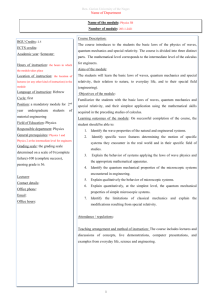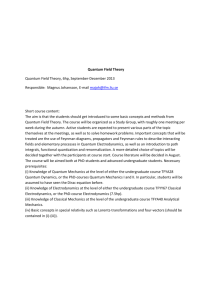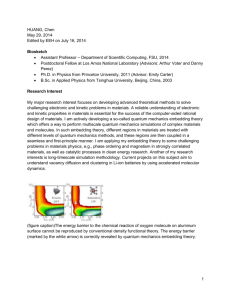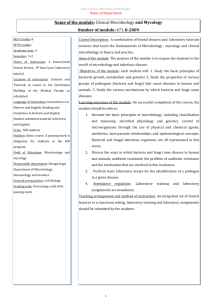203-1-2391
advertisement
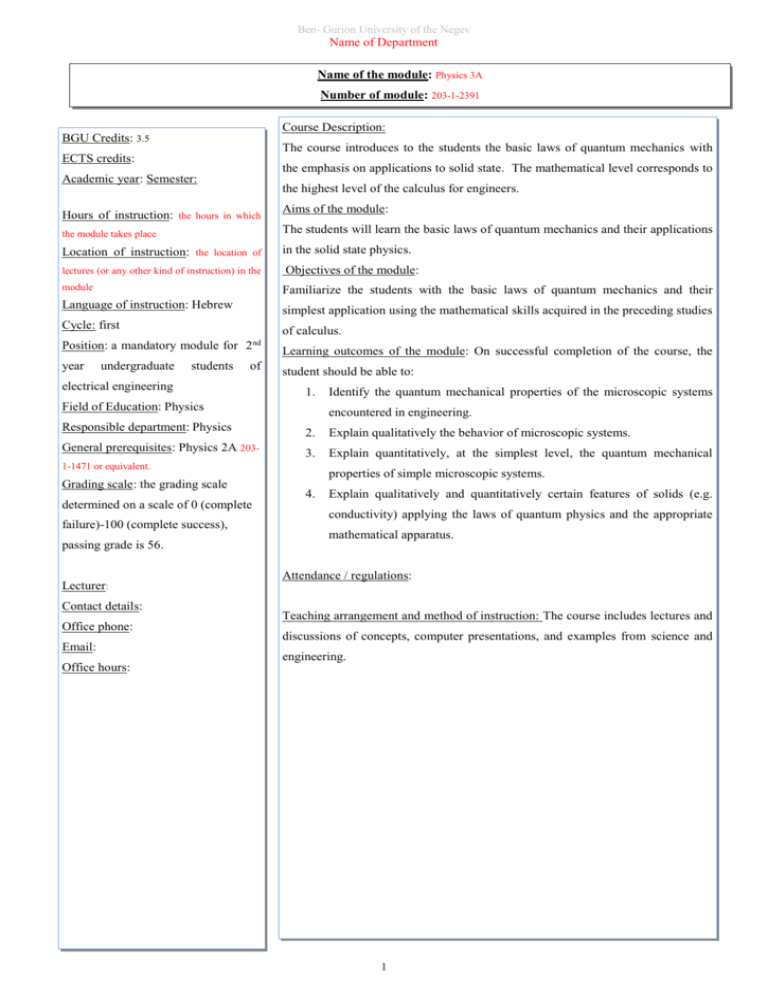
Ben- Gurion University of the Negev Name of Department Name of the module: Physics 3A Number of module: 203-1-2391 Course Description: BGU Credits: 3.5 The course introduces to the students the basic laws of quantum mechanics with ECTS credits: the emphasis on applications to solid state. The mathematical level corresponds to Academic year: Semester: the highest level of the calculus for engineers. Hours of instruction: the hours in which Aims of the module: the module takes place The students will learn the basic laws of quantum mechanics and their applications Location of instruction: the location of in the solid state physics. lectures (or any other kind of instruction) in the module Familiarize the students with the basic laws of quantum mechanics and their Language of instruction: Hebrew simplest application using the mathematical skills acquired in the preceding studies Cycle: first of calculus. Position: a mandatory module for 2 year Objectives of the module: undergraduate students nd of electrical engineering Learning outcomes of the module: On successful completion of the course, the student should be able to: 1. Field of Education: Physics Identify the quantum mechanical properties of the microscopic systems encountered in engineering. Responsible department: Physics 2. Explain qualitatively the behavior of microscopic systems. General prerequisites: Physics 2A 203- 3. Explain quantitatively, at the simplest level, the quantum mechanical 1-1471 or equivalent. Grading scale: the grading scale determined on a scale of 0 (complete failure)-100 (complete success), properties of simple microscopic systems. 4. Explain qualitatively and quantitatively certain features of solids (e.g. conductivity) applying the laws of quantum physics and the appropriate mathematical apparatus. passing grade is 56. Attendance / regulations: Lecturer: Contact details: Office phone: Email: Teaching arrangement and method of instruction: The course includes lectures and discussions of concepts, computer presentations, and examples from science and engineering. Office hours: 1 Ben- Gurion University of the Negev Name of Department Module evaluation: at the end of the Assessment: semester the students will evaluate the module, how the students will be assessed in the module in order to draw conclusions, and for the 1. Final exam 100% university's internal needs 100% Confirmation: the syllabus was confirmed by the academic advisory committee of the department of physics to be valid on XXX (academic year) Last update: when was the last update of the syllabus Work and assignments: 1. Weekly homework submission compulsory. 2. Examination dates are fixed by the administrative staff. detailed instructions for the students regarding the work and assignments in the module (including dates of examination and due dates) Time required for individual work: in addition to attendance in class, the students are expected to do their assignment and individual work: a definition of the amount of hours that the students are expected to invest in the module learning process, including reading assignments, etc. according to that section the module's ECTS is calculated. 2 Ben- Gurion University of the Negev Name of Department Module Content\ schedule and outlines: Each topic – 3 hours, 1-2) General motivation, the photoelectric effect, waves, photons - energy and momentum. Double-slit experiment – a qualitative description. De Broglie principle. The Drude model classically explaining conduction. The failure of the classical model. Fourier transform 3-4) Probability function, Schrödinger equation, normalization, a wave packet describing a free particle (discrete or continuous Fourier transform representation), uncertainty principle for a wave packet, time independent Schrödinger equation 5-6) An infinite potential well - in one, two and three dimensions, a square well, definition of degeneracy, density of states, tunneling 7-8) The basic concepts of quantum mechanics: a definition of a state, physical variables as operators, the principal of spectral decomposition, an expectation value, standard deviation, commutation relations, probability current 9) One-dimensional harmonic oscillator, a raising or lowering operator (" ladder" operators) 10) A lattice, the reciprocal lattice, Brillouin zone 11-12) - - A particle in a periodic potential, Bloch's theorem, the Kronig-Penny model, energy bands, energy gap, conduction as explined by quantum theory, effective mass 13) Principles of problem solving Required reading: C Cohen Tannoudji, Quantum mechanics, vol. I (1977) C. Kittel, Introduction to solid state physics, 7th edition (1986) N. W. Aschroft, N. D. Mermin, Solid state physics (1976) J.M. Cassels, Basic Quantum Mechanics, 2nd edition (1982) * All learning material will be available to the students on the module's website (high-learn)/ library/ electronic documents available to BGU students. 3
